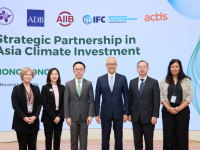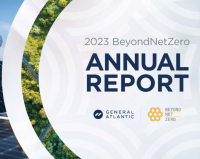
Marguerite joins Net Zero Asset Managers initiative
Marguerite has joined the Net Zero Asset Managers (NZAM) initiative, committing to align its portfolio with net zero emissions by 2050 or sooner. This aligns with the strategy of its Marguerite III fund, which only invests in projects supporting the Paris Agreement’s goals.

Luxembourg, 26 June 2024 – Marguerite, a pan-European infrastructure investor, has joined the Net Zero Asset Managers (NZAM) initiative and commits to align its portfolio with net zero emissions pathways by 2050 or sooner.
This commitment is in line with the strategy of the latest fund – Marguerite III – which only makes investments aligned with the Paris Agreement.
“Joining the Net Zero Asset Managers initiative was more a confirmation than a strategy shift. By joining the NZAM, we formally commit to continue our long history of investing with sustainable strategies,” said Pilar Gomez, partner and head of ESG at Marguerite.
Launched in December 2020, the Net Zero Asset Managers initiative aims “to support the asset management industry to commit to a goal of net zero emissions in order to mitigate financial risk and to maximise long-term value of assets”.
“Since our creation, we have supported the reduction of greenhouse gas emissions by channelling capital into climate solutions, engaging companies to further lower their impact and ensuring the portfolio’s resilience to climate change. This is why we decided to join the Net Zero Asset Managers initiative and commit long-term to fully aligning our investments with the Paris Agreement,” said Pilar Gomez.
There will be an interim commitment for the proportion of investments to be managed in line with a net zero emissions target by 2050, which sets short-term goals with regular decarbonisation pathway monitoring and updates. Marguerite plans to engage with its portfolio companies to help them achieve real emissions reductions on their direct (scope 1) and indirect (scope 2) emissions and, when material, emissions within their supply chain (scope 3).
“To deliver, we commit to supporting our portfolio companies on their decarbonisation journey by either marginally adapting their business plans or introducing more profound transformative programs,” said Pilar Gomez.
Marguerite plans to continue investing in companies helping them to lower GHG emissions, such as renewable energy producers, energy efficiency solution providers, and low-carbon transportation companies, among others.
Marguerite’s latest ESG report is available here.
This commitment is in line with the strategy of the latest fund – Marguerite III – which only makes investments aligned with the Paris Agreement.
“Joining the Net Zero Asset Managers initiative was more a confirmation than a strategy shift. By joining the NZAM, we formally commit to continue our long history of investing with sustainable strategies,” said Pilar Gomez, partner and head of ESG at Marguerite.
Launched in December 2020, the Net Zero Asset Managers initiative aims “to support the asset management industry to commit to a goal of net zero emissions in order to mitigate financial risk and to maximise long-term value of assets”.
“Since our creation, we have supported the reduction of greenhouse gas emissions by channelling capital into climate solutions, engaging companies to further lower their impact and ensuring the portfolio’s resilience to climate change. This is why we decided to join the Net Zero Asset Managers initiative and commit long-term to fully aligning our investments with the Paris Agreement,” said Pilar Gomez.
There will be an interim commitment for the proportion of investments to be managed in line with a net zero emissions target by 2050, which sets short-term goals with regular decarbonisation pathway monitoring and updates. Marguerite plans to engage with its portfolio companies to help them achieve real emissions reductions on their direct (scope 1) and indirect (scope 2) emissions and, when material, emissions within their supply chain (scope 3).
“To deliver, we commit to supporting our portfolio companies on their decarbonisation journey by either marginally adapting their business plans or introducing more profound transformative programs,” said Pilar Gomez.
Marguerite plans to continue investing in companies helping them to lower GHG emissions, such as renewable energy producers, energy efficiency solution providers, and low-carbon transportation companies, among others.
Marguerite’s latest ESG report is available here.
LikeDiscussion
Share
Discussion
You are commenting on Marguerite joins Net Zero Asset Managers initiative
You must be logged in to add a comment
There are no comments
Be the first to add to the discussion
Fund manager

Marguerite
Luxembourg, LuxembourgMarguerite is a pan-European investor in long-life greenfield and brownfield expansion infrastructure.
Our funds seek out capital-intensive, sustainable investment opportunities with a particular focus on four sectors: (1) Energy & Renewables, (2) Digital Transformation, (3) Waste & Water and (4) Transport.
Marguerite manages four European infrastructure funds, the most recent being Marguerite III. Over the years, we’ve deployed in excess of €1.5 billion into projects designed to address the changing infrastructure landscape in Europe by integrating ESG principles and creating positive change for society.
Marguerite III benefits from support from the European Union under the InvestEU Fund.
From our origins in 2010 as an independent infrastructure investment manager backed by the European Investment Bank and the main European National Promotional Banks, we have evolved into a fund manager dedicated to generating value for investors while integrating robust ESG screening as part of our eligibility criteria and continuously measuring the positive impact of our investments.
Our team is based in Luxembourg and Paris.
infrastructure
Related news


Marguerite announces team promotions
Marguerite has announced a series of promotions in recognition of key team members' contributions.

Hong Kong monetary authority anchors actis’ Asia climate strategy to support decarbonisation in Asia

Marguerite invests alongside Azimut Infrastrutture per la Crescita-ESG fund in FibreConnect for the development of ultra-broadband in Italy

NextEnergy Group maintains carbon neutrality since 2022

Marguerite to invest in AQS, a leading Norwegian service vessel operator

Ardabelle Capital Announces Strategic Partnership with TPG NEXT

General Atlantic Publishes its 2023 BeyondNetZero Fund Annual Report

NextEnergy Group Launches its New Sustainability Strategy
